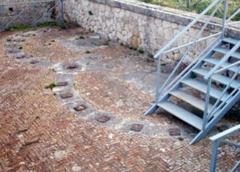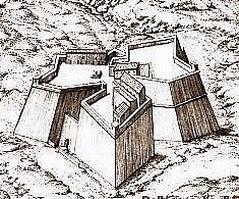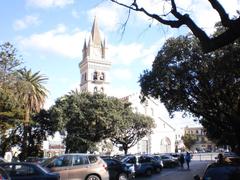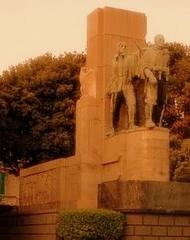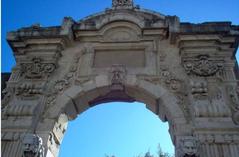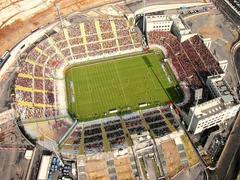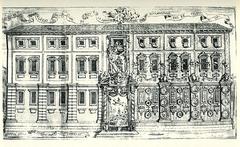
Forte del Santissimo Salvatore, Messina, Italy: Visiting Hours, Tickets, and Travel Guide
Date: 04/07/2025
Introduction
Forte del Santissimo Salvatore stands at the northeastern tip of Messina, Sicily, as a commanding testament to the city’s rich maritime, religious, and military history. This fortress, occupying a site once home to a medieval monastery and the 11th-century Tower of Saint Anne, reflects centuries of transformation—from a spiritual sanctuary to a Renaissance stronghold. Built between 1537 and 1546 under Spanish rule to counter Ottoman threats, its formidable bastions and thick stone walls are prime examples of Renaissance military architecture. Over the centuries, the fort has survived pivotal historical events and devastating earthquakes, symbolizing Messina’s resilience. Today, it offers visitors sweeping views of the Strait of Messina, cultural exhibitions, and an immersive journey through Sicilian history (historica.fandom.com; Visit Sicily; Comune di Messina).
This guide provides up-to-date details on visiting hours, ticketing, accessibility, guided tours, and the best ways to enrich your visit to one of Sicily’s most remarkable landmarks.
Table of Contents
- Historical Background
- Architectural Features
- Cultural and Religious Significance
- Visiting Hours and Tickets
- Accessibility and Travel Tips
- Guided Tours and Special Events
- Nearby Attractions
- Frequently Asked Questions (FAQ)
- Resources and Further Reading
Historical Background
Origins and Medieval Foundations
Before the present fortress, the San Raineri peninsula hosted a monastery and church dedicated to the Holy Savior (Santissimo Salvatore) and the Tower of Saint Anne, constructed in 1081. The tower played a key role in the Sicilian Vespers revolt of 1282, marking the area as a strategic and symbolic site in Messina’s medieval history (historica.fandom.com).
Renaissance Construction (1537–1546)
Responding to the growing Ottoman threat in the 16th century, Spanish rulers demolished existing religious structures to construct the Forte del Santissimo Salvatore. Its angular bastions and stone walls were built to withstand artillery, representing the era’s advanced military architecture. The fortress protected Messina’s vital harbor, anchoring a network of coastal defenses established by the Spanish throughout Sicily.
Catastrophe and Reinvention
In 1549, a catastrophic explosion in the fort’s gunpowder magazine caused extensive damage, prompting reconstruction and further enhancement of its defensive features.
Key Moments in Military History
- 17th Century Revolt: In 1674, anti-Habsburg rebels seized the fortress during a citywide uprising, only for it to be retaken by loyalist forces in 1678 (historica.fandom.com).
- Risorgimento Era: The Bourbon garrison used the fortress to defend Messina during Garibaldi’s Expedition of the Thousand in 1860, holding out until its capture by Piedmontese troops in 1861.
- Natural Disasters: The fort survived the earthquakes of 1783 and, most devastatingly, 1908. Each time, it was restored, cementing its role as a symbol of Messina’s endurance.
Architectural Features
- Bastions and Ramparts: The fortress’s star-shaped design, thick stone walls, and angular bastions were built to repel artillery fire and control harbor access.
- Torre della Lanterna: This 35-meter cylindrical tower served as a lighthouse and lookout, and remains a defining feature of the site (Comune di Messina).
- Torre di Sant’Anna: The oldest surviving element, dating back to 1081, is embedded within the Renaissance fortifications.
- Madonna della Lettera Statue: The iconic 18-meter gilded bronze statue was installed in 1934 atop the Torre della Lanterna, embodying Messina’s spiritual guardianship.
- Casemates and Bastions: Vaulted chambers and bastions originally housed artillery and munitions, reflecting the evolution of military technology.
Cultural and Religious Significance
- Spiritual Heritage: The site’s transformation from a monastery to a fortress did not erase its religious identity. The Madonna della Lettera statue, inscribed with “Vos et ipsam civitatem benedicimus,” signifies Messina’s patronage and faith (Sicily.co.uk).
- Civic Symbol: The fort serves as a repository of local memory, housing commemorative plaques, period cannons, and artifacts rescued from the 1908 earthquake.
- Cultural Exhibitions: The fortress often hosts exhibitions such as “Miti e correnti dello Stretto” (original nautical charts and prints), “Sala Storica del Nucleo Supporto Logistico” (history of the port), and “Sala Storica dei Fari e dei Segnalamenti” (lighthouses and maritime signals).
Visiting Hours and Tickets
- Standard Hours: Open Tuesday to Sunday, 9:00 AM – 6:00 PM. Closed Mondays and public holidays.
- Special Openings: Actual access may be restricted due to the site’s management by the Italian Navy. Public openings are often scheduled during heritage days or special events. Always verify the latest schedule on the official Messina tourism website.
- Ticket Prices: Admission is generally free, with donations encouraged for preservation. Guided tours may have fees—typically €5 for adults, €3 for students and seniors, and free for children under 12.
- Booking: Guided tours and group visits must be booked in advance, especially for special events (Messina Tourism Website).
Accessibility and Travel Tips
- Getting There: The fort is located at the end of the San Raineri peninsula, approximately 2 km from Piazza Duomo. It is accessible by foot, taxi, or local buses (ATM Messina).
- Site Accessibility: The historic structure features uneven terrain and stairs, making some areas less accessible for those with mobility challenges. Assistance is available at the entrance on request.
- Visitor Tips:
- Wear comfortable shoes.
- Bring water and sun protection.
- Dress modestly, respecting the site’s religious and military heritage.
- Facilities are limited; plan accordingly.
Guided Tours and Special Events
- Guided Tours: Available in Italian and English, typically on weekends or by appointment. Tours include access to bastions, terraces, and exhibitions, enriching the historical experience.
- Events: The fort hosts historical reenactments, art exhibitions, and the annual Madonna della Lettera festival on June 3rd, featuring processions and fireworks (Messina Today). Advance booking is recommended for special events.
Nearby Attractions
- Messina Cathedral (Duomo di Messina): Renowned for its astronomical clock, Norman architecture, and vibrant piazza (Duomo Messina).
- Regional Museum of Messina: Features art, including works by Caravaggio (Museo Regionale di Messina).
- Passeggiata a Mare: A scenic waterfront promenade.
- Real Cittadella: The ruins of another historic fortress nearby.
A half-day itinerary can easily combine these highlights for a full cultural immersion.
Frequently Asked Questions (FAQ)
Q: What are the Forte del Santissimo Salvatore visiting hours?
A: Typically open Tuesday to Sunday, 9:00 AM – 6:00 PM, but actual openings may be limited. Always check the official website for the latest schedule.
Q: Is there a ticket fee?
A: Admission is generally free, with optional donations. Fees may apply for guided tours.
Q: Are guided tours available?
A: Yes, tours are offered in Italian and English, usually by prior arrangement.
Q: How do I get to the fort from Messina center?
A: It’s about 2 km from Piazza Duomo—walk, taxi, or local bus options are available.
Q: Is the fort accessible for those with disabilities?
A: Some areas are inaccessible due to uneven surfaces and stairs. Assistance can be requested at the entrance.
Q: Can I combine my visit with other attractions?
A: Absolutely, nearby sites include the Messina Cathedral and the Regional Museum.
Conservation and Restoration
Ongoing projects by the Italian Ministry of Culture aim to preserve the structure, stabilize ramparts, restore the Torre della Lanterna, and enhance visitor access (Ministero della Cultura). Respect site guidelines and consider supporting through donations or volunteering.
Visual and Interactive Resources
Summary and Recommendations
Forte del Santissimo Salvatore is a cornerstone of Messina’s identity—blending spiritual, military, and civic history in a single dramatic location. Its robust Renaissance architecture, evocative exhibitions, and stunning views over the Strait of Messina make it a must-see for visitors. Plan ahead by checking opening times, booking a guided tour, and combining your visit with other city landmarks. For a richer experience, use virtual tours, download the Audiala app for audio guides, and follow local tourism platforms for updates and inspiration (historica.fandom.com; Messina Tourism Website; Ministero della Cultura).
References and Further Reading
- Forte del Santissimo Salvatore, Historica Fandom
- Visit Sicily: Forte del Santissimo Salvatore
- Comune di Messina: Forte del Santissimo Salvatore
- Messina Tourism Website
- Ministero della Cultura



